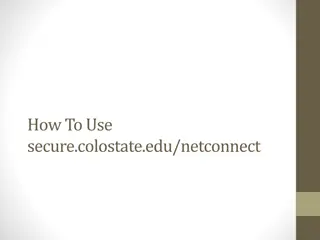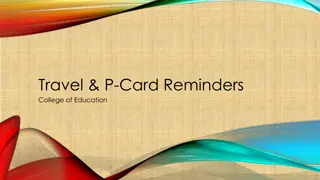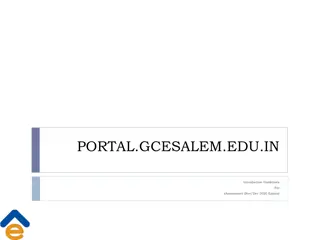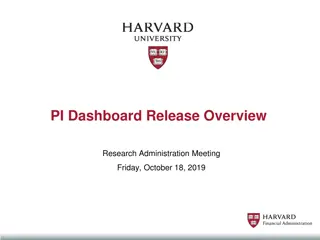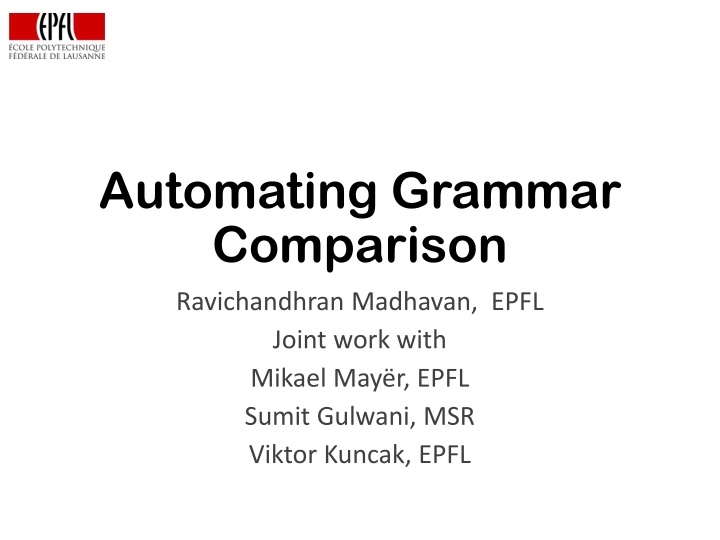
Innovative Grammar Comparison Techniques for Programming Languages
Explore how automated tools can compare and analyze grammar structures in programming languages, helping in detecting errors, resolving incompatibilities, and enhancing language development. Discover the significance of ensuring consistency and accuracy in grammar definitions.
Download Presentation

Please find below an Image/Link to download the presentation.
The content on the website is provided AS IS for your information and personal use only. It may not be sold, licensed, or shared on other websites without obtaining consent from the author. If you encounter any issues during the download, it is possible that the publisher has removed the file from their server.
You are allowed to download the files provided on this website for personal or commercial use, subject to the condition that they are used lawfully. All files are the property of their respective owners.
The content on the website is provided AS IS for your information and personal use only. It may not be sold, licensed, or shared on other websites without obtaining consent from the author.
E N D
Presentation Transcript
Automating Grammar Comparison Ravichandhran Madhavan, EPFL Joint work with Mikael May r, EPFL Sumit Gulwani, MSR Viktor Kuncak, EPFL
Overview unit -> pkg? imp* type* field -> method | vard | arglist -> exp (, exp)* Proven Equivalent Context-free grammars Counter-examples cu -> pd? impd* classd* pd -> annot* package qname; impd -> import static? qname (. '*')? ; Verifier for Grammar Equivalence final protected interface Id { } ; public synchronized enum Id { , } ...
Applications Programming Languages CS Education Compare grammars used by parsers Automate grading of grammar exercises Unravel incompatibilities / bugs Aid in tutoring grammars http://grammar.epfl.ch Catch errors in rewriting
Comparing PL Grammars Does it accept all syntactically correct programs ? Does it accept only syntactically correct programs ? Javascript Grammar
Reality Check Analyzed grammars of 5 programming languages Grammars disagree on > 40% of words sampled at random Oracle JLS vs Antlr Java private private public public class ID implements char { } interface ID { ; short ID = ~ + CharLiteral /= Null -- % IntLiteral == this <<= FloatLiteral ; } Overly Permissive
Incompatibilities Mozilla JS Grammar vs ECMA Script standard eval("var k = function() { }"); ++ /a/ this Parse Error Reference Error No Error
Grammar Rewrite Tasks Grammars have to be modified for many reasons Remove ambiguity Remove left recursion Eliminate shift / reduce conflicts (LR) Enable recursive descent parsing (LL)
Our Contribution Fast and deep counter-example detection 100% Finds hundreds of counter-examples between real world grammars 90% 80% 70% 60% Detects incremental modifications 50% 40% 30% 20% 3x more effective and 12x faster than available state of the art 10% 0% Queries disproved Speedup Our tool CFG Analyzer
Grammars from English Descriptions Construct an LL(1) grammar for function types over Int Int Int => Int Int , Int => Int Correct but not LL(1) Solution 1 type args => type | Int args Int , args | Int Reference type Int rest rest => type | ,Int args | args ,Int args | => type Solution 2 S Int U U => Int U | , Int U | Incorrect but LL(1)
Second Contribution Tutoring system for Context-free grammars Can find counter-examples as well as prove equivalence 100% 90% 80% 70% 60% Decided 95.3% of 1395 student queries Free and open source http://grammar.epfl.ch 50% 40% 30% 20% 10% 0% Students' Solutions Disproved Proved Unknown
Counter-Example Discovery unit -> pkg? imp* type* field -> method | vard | arglist -> exp (, exp)* Enumerate / Sample Parse Antlr LL(1) cu -> pd? impd* classd* pd -> annot* package qname; impd -> import static? qname (. '*')? ; CYK
Enumeration of Words & Parse Trees We consider enumeration of parse trees 0 1 2 3 4 5 We define the function Enum(S, i) that returns the ith parse tree rooted at S
Random Lookup - Illustration T P Q | b P P a | Q P Q b | P Q T, 100 Choose step 1 P Q, 50 Unpair step P, 4 Q,5 Choose step 2 Q P, 3 P Q, 4 Q,2 P, 0 P, 1 Q,1 a b b a b b b b
Advanced Features Parametrized by word length Enumerates only parse trees of words of specified length Uniform random sampling of parse trees Supports sampling uniformly from parse trees of words of given length Fair Enumeration Fair usage of productions and non-terminals
Theoretical Algorithms for Equivalence Deterministic Grammars G. Snizergues Sub-deterministic grammars Valiant LL(k) Harrison & Havel Olshansky & Pnueli Rosenkrantz & Stearns LL(1) Korenjak & Hopcroft
Our Algorithm Combines Korenjak & Hopcroft Harrison & Havel Olshansky & Pnueli More General Applies to arbitrary, ambiguous grammars Complete for LL(2) grammars Practical Applied to grading pedagogical exercises
Algorithm Illustration Two grammars for anbn S a T T a T U | b U b P a R R a b b | a R b | b Ambiguous Goal: To find a derivation for ? P
Proving Equivalence S a T T a T U | b U b P a R R a b b | a R b | b True True True True True R T b U T R U b TU Rb bb TU Rb TU TU bb Rb bb Rb TU TU bb Rb T R S P
Proving Equivalence S a T T a T U | b U b P a R R a b b | a R b | b True True True True True R T b U T R U b TU Rb bb TU Rb TU TU bb Rb bb Rb TU TU bb Rb Branch Rule T R S P
Proving Equivalence S a T T a T U | b U b P a R R a b b | a R b | b True True True True True R T b U T R U b TU Rb bb TU Rb TU TU bb Rb bb Rb TU TU bb Rb Equivalence to Inclusion T R S P
Proving Equivalence S a T T a T U | b U b P a R R a b b | a R b | b True True True True True R T b U T R U b TU Rb bb TU Rb TU TU bb Rb bb Rb TU TU bb Rb Enumeration Rule T R S P
Proving Equivalence S a T T a T U | b U b P a R R a b b | a R b | b True True True True True R T b U T R U b TU Rb bb TU Rb TU TU bb Rb bb Rb TU TU bb Rb Split Rule T R T U R b S P b b
Proving Equivalence S a T T a T U | b U b P a R R a b b | a R b | b True True True True True R T b U T R U b TU Rb bb TU Rb TU TU bb Rb bb Rb TU TU bb Rb Inductive Reasoning T R S P
Benchmarks Java 7 JavaScript C 11 Pascal VHDL Compared two grammars per benchmark Average Size: 213 non-terminals & 420 productions
Injecting Injecting Fine grained Errors Fine grained Errors Type 1: Removing a production at random Type 2: Removing a nonterminal of a production at random Type 3: Disabling a production in a specific context at random P a Q Q a c | d P a Q Q a c Q a c | d
Detecting Fine grained Detecting Fine grained Errors Errors Errors Discovered 100 Mean time / error found Our tool: 28s CFG analyzer: 343s 80 60 Mean counter-example length Our tool: 35 CFG analyzer: 12.2 40 20 0 Our tool CFG Analyzer
Tutoring System Tutoring System Evaluations Evaluations Queries Queries Refuted Refuted Proved Proved Unknown Unknown Time Time / / query query 1395 1042 74.6% 289 20.7% 64 4.6% 107ms Evaluated the system on a class of 50 students The tutoring system has 5 types of exercises & 60 problems
Equivalence Equivalence Prover Evaluations Evaluations Prover Invocations Invocations Proved Proved Time / Time / query query LL(2) LL(2) queries queries Ambiguous Ambiguous quer queries ies 353 289 81.9% 410ms 63 18% 101 28.6%
Conclusion Conclusion Tool support for testing compiler grammars Discovering counter-examples between large programming language grammars Automating tutoring and evaluation of grammars Prove or disprove students solutions and provide feedback More useful in the context of MOOCs http://grammar.epfl.ch




